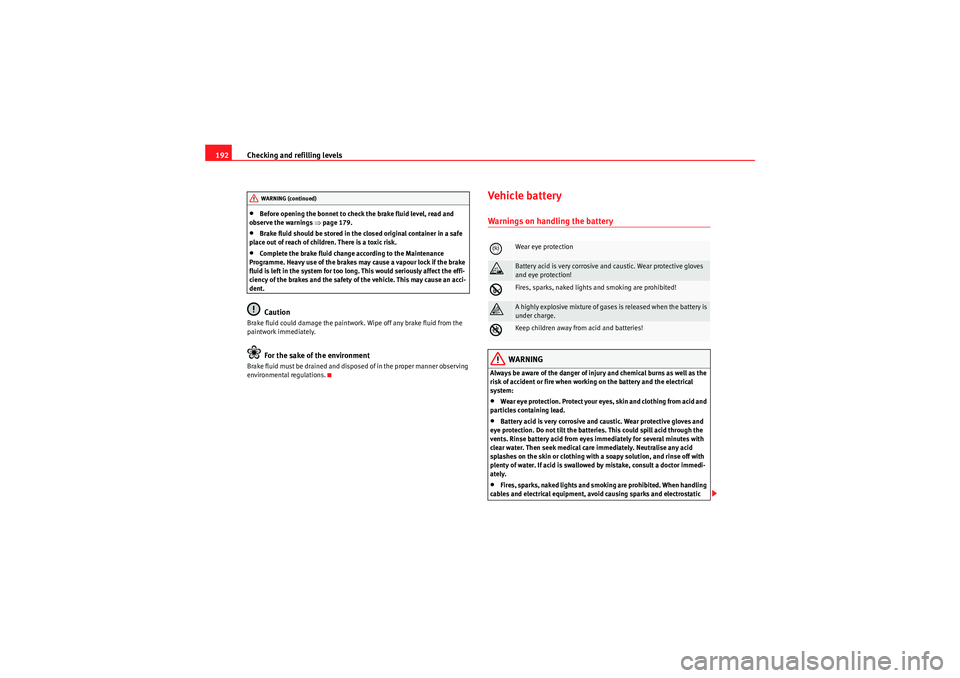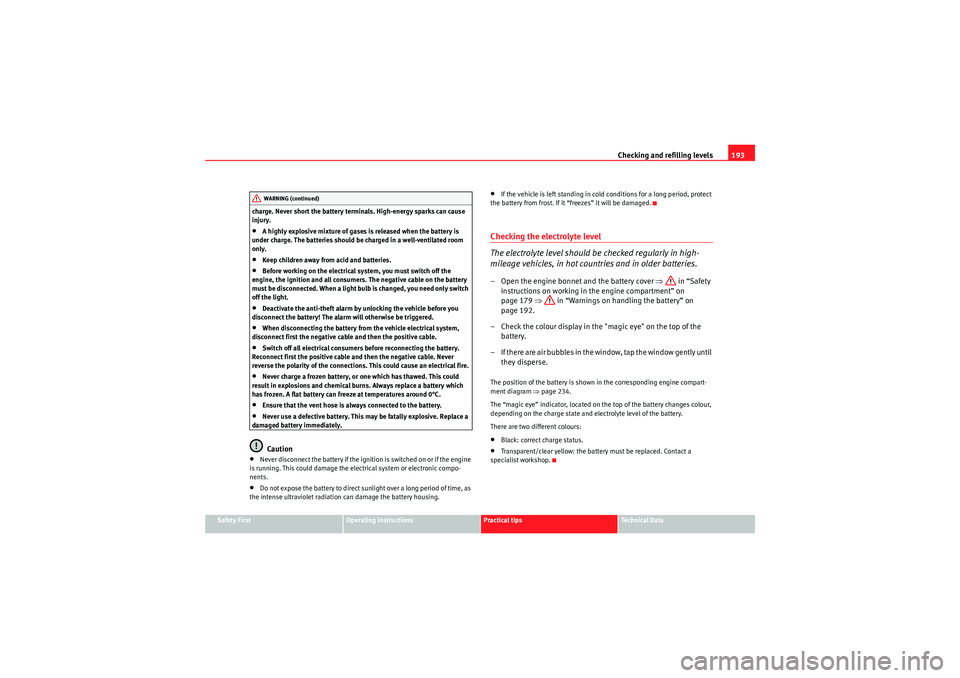Page 192 of 250

Checking and refilling levels191
Safety First
Operating instructions
Practical tips
Technical Data
Brake fluidChecking the brake fluid level
The brake fluid is checked at the intervals given in the service
schedule.– Read off the fluid level at the transparent brake fluid reservoir. It
should always be between the “MIN” and “MAX” marks.The position of the brake fluid reservoir is shown in the corresponding engine
compartment illustration ⇒page 234. The brake fluid reservoir has a black
and yellow cap.
The brake fluid level drops slightly when the vehicle is being used as the
brake pads are automatically adjusted as they wear. However, if the level goes down noticeably in a short time, or drops below the
“MIN” mark, there may be a leak in the brake system. A display on the instru-
ment panel will warn you if the brake fluid level is too low
⇒page 56.
WARNING
Before opening the bonnet to check the brake fluid level, read and observe
the warnings ⇒page 179.Changing the brake fluid
The Maintenance Programme indicates the brake fluid
change intervals.We recommend that you have the brake fluid changed by an Authorised
Service Centre.
Before opening the bonnet, please read and follow the warnings ⇒ in
“Safety instructions on working in the engine compartment” on page 179 in
section “Safety notes for working in the engine compartment”.
Brake fluid absorbs moisture. In the course of time, it will absorb water from
the ambient air. If the water content in the brake fluid is too high, the brake
system could corrode. This also considerably reduces the boiling point of the
brake fluid. Heavy use of the brakes may then cause a vapour lock which
could impair the braking effect.
It is important that you use only brake fluid compliant with US standard
FMVSS 116 DOT 4. We recommend the use of Genuine SEAT brake fluid.
WARNING
Brake fluid is poisonous. Old brake fluid impairs the braking effect.
Fig. 128 In the engine
compartment: Brake fluid
reservoir cover
Ibiza ST_EN.book Seite 191 Dienstag, 12. Januar 2010 4:03 16
Page 193 of 250

Checking and refilling levels
192•Before opening the bonnet to check the brake fluid level, read and
observe the warnings ⇒page 179.•Brake fluid should be stored in the closed original container in a safe
place out of reach of children. There is a toxic risk.•Complete the brake fluid change according to the Maintenance
Programme. Heavy use of the brakes may cause a vapour lock if the brake
fluid is left in the system for too long. This would seriously affect the effi-
ciency of the brakes and the safety of the vehicle. This may cause an acci-
dent.Caution
Brake fluid could damage the paintwork. Wipe off any brake fluid from the
paintwork immediately.
For the sake of the environment
Brake fluid must be drained and disposed of in the proper manner observing
environmental regulations.
Vehicle batteryWarnings on handling the battery
WARNING
Always be aware of the danger of injury and chemical burns as well as the
risk of accident or fire when working on the battery and the electrical
system:•Wear eye protection. Protect your eyes, skin and clothing from acid and
particles containing lead.•Battery acid is very corrosive and caustic. Wear protective gloves and
eye protection. Do not tilt the batteries. This could spill acid through the
vents. Rinse battery acid from eyes immediately for several minutes with
clear water. Then seek medical care immediately. Neutralise any acid
splashes on the skin or clothing with a soapy solution, and rinse off with
plenty of water. If acid is swallowed by mistake, consult a doctor immedi-
ately.•Fires, sparks, naked lights and smoking are prohibited. When handling
cables and electrical equipment, av oid causing sparks and electrostatic
WARNING (continued)
Wear eye protection
Battery acid is very corrosive and caustic. Wear protective gloves
and eye protection!
Fires, sparks, naked lights and smoking are prohibited!
A highly explosive mixture of gases is released when the battery is
under charge.
Keep children away from acid and batteries!
Ibiza ST_EN.book Seite 192 Dienstag, 12. Januar 2010 4:03 16
Page 194 of 250

Checking and refilling levels193
Safety First
Operating instructions
Practical tips
Technical Data
charge. Never short the battery terminals. High-energy sparks can cause
injury.
•A highly explosive mixture of gases is released when the battery is
under charge. The batteries should be charged in a well-ventilated room
only.•Keep children away from acid and batteries.•Before working on the electrical system, you must switch off the
engine, the ignition and all consumers. The negative cable on the battery
must be disconnected. When a light bulb is changed, you need only switch
off the light.•Deactivate the anti-theft alarm by unlocking the vehicle before you
disconnect the battery! The alarm will otherwise be triggered.•When disconnecting the battery from the vehicle electrical system,
disconnect first the negative cable and then the positive cable.•Switch off all electrical consumers before reconnecting the battery.
Reconnect first the positive cable and then the negative cable. Never
reverse the polarity of the connections. This could cause an electrical fire.•Never charge a frozen battery, or one which has thawed. This could
result in explosions and chemical burns. Always replace a battery which
has frozen. A flat battery can freeze at temperatures around 0°C.•Ensure that the vent hose is always connected to the battery.•Never use a defective battery. This may be fatally explosive. Replace a
damaged battery immediately.Caution
•Never disconnect the battery if the ignition is switched on or if the engine
is running. This could damage the electrical system or electronic compo-
nents.•Do not expose the battery to direct sunlight over a long period of time, as
the intense ultraviolet radiation can damage the battery housing.
•If the vehicle is left standing in cold conditions for a long period, protect
the battery from frost. If it “freezes” it will be damaged.Checking the electrolyte level
The electrolyte level should be checked regularly in high-
mileage vehicles, in hot countries and in older batteries.– Open the engine bonnet and the battery cover ⇒ in “Safety
instructions on working in the engine compartment” on
page 179 ⇒ in “Warnings on handling the battery” on
page 192.
– Check the colour display in the "magic eye" on the top of the battery.
– If there are air bubbles in the window, tap the window gently until they disperse.The position of the battery is shown in the corresponding engine compart-
ment diagram ⇒page 234.
The “magic eye” indicator, located on the top of the battery changes colour,
depending on the charge state and electrolyte level of the battery.
There are two different colours:•Black: correct charge status.•Transparent/clear yellow: the battery must be replaced. Contact a
specialist workshop.
WARNING (continued)
Ibiza ST_EN.book Seite 193 Dienstag, 12. Januar 2010 4:03 16
Page 215 of 250
If and when
214Changing bulbs. Double headlightsDouble headlights summary
Main beam
Side lights
Dipped beam headlights
Side lights
Turn signal light
Main beam and side lights– Raise the bonnet.
Fig. 139 Double head-
lights
AAABACADAE
Fig. 140 Main beam
headlightsFig. 141 Main beam
headlights
Ibiza ST_EN.book Seite 214 Dienstag, 12. Januar 2010 4:03 16
Page 216 of 250
If and when215
Safety First
Operating instructions
Practical tips
Technical Data
– Move the loop in the direction of the arrow and remove the
cover ⇒page 214, fig. 140 .
– Remove connector ⇒ page 214, fig. 141 by pulling outward.
– Extract the bulb and fit the replacement so that it sits correctly into the cut-out on the reflector.
– Installation is done in the reverse order.Dipped beam and side lights
– Raise the bonnet.
– Remove the loop ⇒fig. 142 in the direction of the arrow and
remove the cover.
– Remove the connector ⇒fig. 143 from the bulb.
– Unclip the retainer spring ⇒fig. 143 pressing inwards to the
right.
– Extract the bulb and fit the replacement so that the rim of the attachment plate is on the reflector cut-out.
A1
A2Fig. 142 Dipped beam
headlights
Fig. 143 Dipped beam
headlights
A1
A2A3
Ibiza ST_EN.book Seite 215 Dienstag, 12. Januar 2010 4:03 16
Page 217 of 250
If and when
216Turn signal bulb– Raise the bonnet.
– Rotate the bulb holder ⇒fig. 144 to the left and pull.
– Remove the bulb by pressing on the bulb holder and rotating at the same time to the left.
– Installation is done in the reverse order.
Changing bulbs. Single headlightSingle headlights summary
Dipped/main beam headlights
Side lights.
Turn signal
Fig. 144 Turn signal light
AA
Fig. 145 Single headlight
AAABAC
Ibiza ST_EN.book Seite 216 Dienstag, 12. Januar 2010 4:03 16
Page 218 of 250
If and when217
Safety First
Operating instructions
Practical tips
Technical Data
Dipped/main beam headlights – Raise the bonnet. – Remove the loop
⇒fig. 146 in the direction of the arrow and
remove the cover.
– Remove the connector ⇒fig. 147 from the bulb.
– Unclip the retainer spring ⇒fig. 147 pressing inwards to the
right.
– Extract the bulb and fit the replacement so that the rim of the attachment plate is on the reflector cut-out.
Side lights – Raise the bonnet.
– Move the loop ⇒fig. 146 in the direction of the arrow and
remove the cover.
Fig. 146 Dipped
beam/main beam, single
headlightFig. 147 Dipped
beam/main beam, single
headlight
A1
A2A3
Fig. 148 Side lights
A1
Ibiza ST_EN.book Seite 217 Dienstag, 12. Januar 2010 4:03 16
Page 219 of 250
If and when
218
– Remove the bulb holder ⇒page 217, fig. 148 outwards.
– Replace the bulb by pulling it out and inserting the replacement.
– Installation is done in the reverse order.Turn signal bulb– Raise the bonnet.
– Rotate the bulb holder ⇒fig. 149 to the left and pull.
– Remove the bulb by pressing on the bulb holder and rotating at the same time to the left.
– Installation is done in the reverse order.
Changing the rear lights (on the wing)Overview of tail lightsTail lights in side panel•Brake lights•Side lights•Turn signal lightAccessing the side light bulbs–Open the rear lid.
– Look for a lid with a grill behind the side lights.
A4
Fig. 149 Single turn
signal lamp
AA
Fig. 150 Side lights
Ibiza ST_EN.book Seite 218 Dienstag, 12. Januar 2010 4:03 16